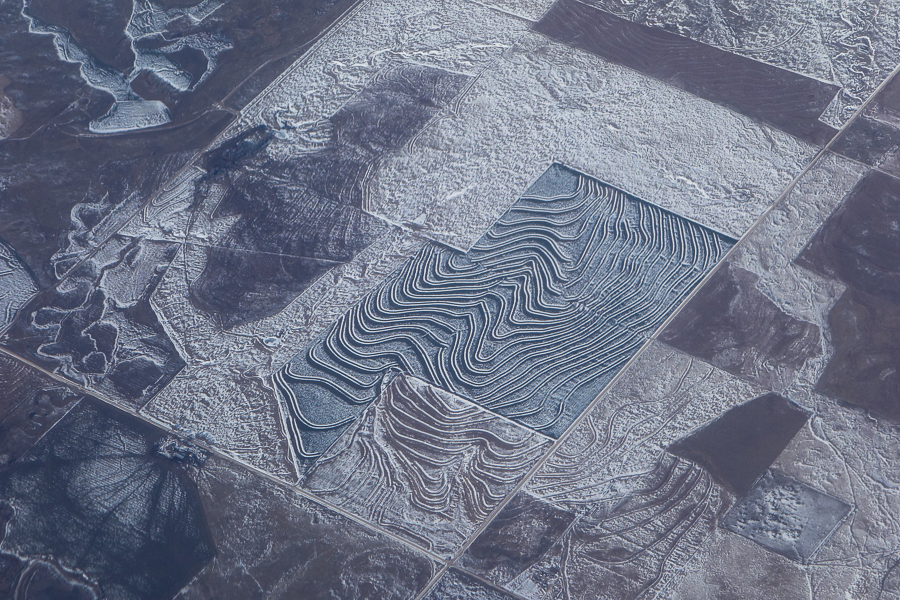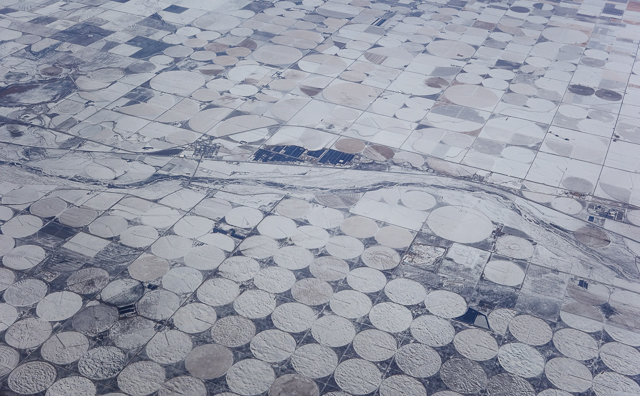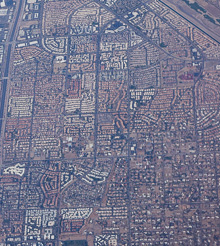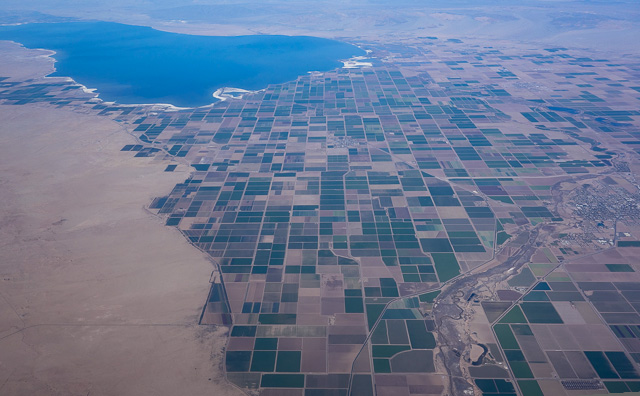
On a flight from Boston to San Diego yesterday I had a window seat on the shady side. The weather was clear, and over much of the continent a dusting of snow combined with low winter sun angles to highlight subtle features of the landscape. It was like flying over a painting—maybe a Mondrian, maybe something by Chuck Close.
The photo above comes from central Kansas, just west of Manhattan. I don’t entirely understand what I’m seeing here. The conspicuous double wavy lines in the fields near the center of the image look like contour plowing, but the scale is all wrong; they are wider than the roads. I think they are either ditches to promote drainage or berms to prevent it. The structures are visible on Google Maps, but there they lack the chiaroscuro effect of snow and sun that gives them such drama here. What accounts for the color differences between fields?

The image above is from 40 minutes earlier in the flight, over southwestern Illinois. Here the rectilinear grid of midwestern agriculture is a mere overlay on dendritic natural drainage patterns, again with bright highlighting. Apparently the snow has been swept off of flat land and gathered on slopes. The overall effect reminds me of military camouflage.

Western Kansas or southeastern Colorado: The landscape has gone all dotty with center-pivot irrigators. Always a cheering sight. If we’re going to turn the country into a checkerboard of quarter-section fields, we might as well put checkers on them. That’s probably the Cimarron River running through the middle of the frame, but I haven’t been able to identify the exact spot.

Above, more painterly drainage patterns, but this time the paintbrush is entirely in the hands of nature. I believe this is northern New Mexico, not far from Farmington.

At right, we’re back on the grid again—sort of. Those tiny chiclets packed together so tighly are residential neighborhoods in Scottsdale, Arizona. They can’t escape the rectilinear pattern defined by the major streets, but inside those squares they do their best to imitate the swirly lanes and cul de sacs of a suburban housing development.
Finally, below, orthagonality reasserts itself with a vengeance in the Imperial Valley in southern California, the desert basin where most of the Colorado River winds up. At the top is the Great Oops called the Salton Sea—or what’s left of it.


Great pictures. My initial guess on the Kansas wavy lines are terraces on hilly ground. Can you check the elevation info on Google Maps?
The reason for different coloring there is probably what crops were planted there and how they were harvested. If corn was cut low and clean for silage, you’ll only see short stalks and dirt. If it was harvested normally, there will be a lot of stalks and debris in the field. Also, sometimes stalks are chopped and even disced (torn up) before the snow which would effect the color and amount of snow that’s trapped in the field.
Irrigated and non-irrigated fields will look differently (especially during a drought like this year). Alfalfa and soybeans will look different from the air as well.
Here’s a Google Maps link to the region in question: Buckeye, KS. Even by Kansas standards it looks pretty flat to me; the 1200-foot contour line snakes all over the area. If you zoom in on some of the fields, you’ll find that the berms or ditches or terraces or whatever are crisscrossed by tractor marks.
The wavy lines might be wind rows of corn left standing to help mitigate effects of drought. The idea is to slow the surface wind and hence retain a bit more soil moisture. We did this in Iowa corn fields in the big drought in the 80s but don’t know if it actually helped, we were just following the ag extension advise.
I wonder if agriculturists are unaware of the hexagonal lattice and its greater coverage. Am I sitting on a goldmine?
I think the hexagonal suggestion refers to the irrigated areas, which are circles and hence not plane-filling for central-pivot irrigation systems. This doesn’t have much to do with the shape of the field, which is much larger than a single irrigation area. The picture also has circular irrigation areas, though the larger pattern has some angles which look hexagonal (but is far from plane-filling).
I’m not sure I understand your comment. By its nature, a center-pivot irrigator sprinkles water on a circular area. When you inscribe that circle in a square field, the fraction of the area covered is \(\pi/4\), or about 0.79. In a regular hexagon, the covered area is \(\frac{\pi \sqrt{3}}{6}\), or 0.91.